On the Road is a weekday feature spotlighting reader photo submissions.
From the exotic to the familiar, whether you’re traveling or in your own backyard, we would love to see the world through your eyes.
One of the benefits of living in flyover country is that lots of interesting birds fly over as well. And some even spend time here. The most prominent winter visitors are hawks, specifically Red-tailed Hawks, which come in an astonishing variety of plumages. Here are a few, from last winter and this winter, to give you a taste of what you could see in Kansas or Oklahoma during the winter months.
And if you like these images, several more like them can be found in my 2020 calendar, The other is Hawks and Owls of Kansas at http://bit.ly/2OHjJVF. If raptors aren’t your cup of tea, you might like Iconic Birds of the World, with birds from Tanzania, Ecuador, Brazil, New Zealand & the good ol’ USA. at http://bit.ly/2qXi3i5
And if you want to see a bird image every day in your twitter feed, just follow me, Albatrossity, at https://twitter.com/DaveRintoul01
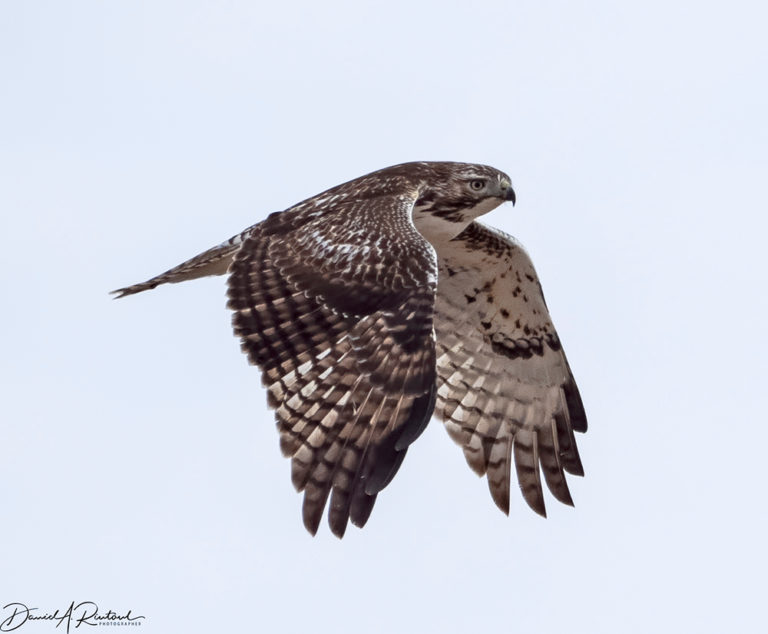
One of the keys to deciphering the plumages of Red-tailed Hawks is to first determine if the bird is an adult, or a youngster hatched last summer. Best clue is the yellow iris, seen well on this young bird of the eastern (borealis) subspecies.
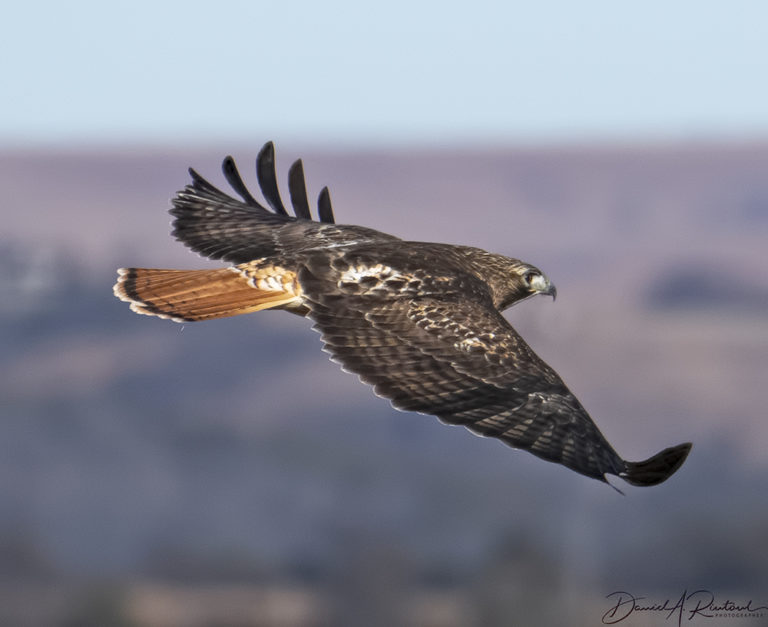
The youngster in the previous image also does not have a red tail, which typically shows up in birds after their first spring/summer molt in their second year. Here is an adult bird, with the eponymous red tail.
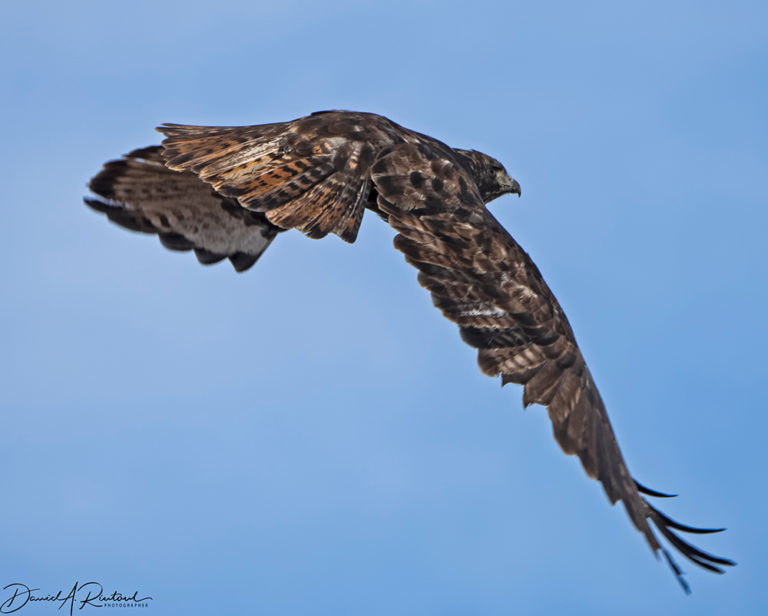
But not all redtailed hawks have that typical brick-red tail. Some, like this one, representing the Harlan’s (harlani) subspecies, have tails of mixed gray, black, and red. That funky tail is a good mark for Harlan’s Hawks, which breed in the Yukon and in Alaska but spend the winter in the Great Plains.
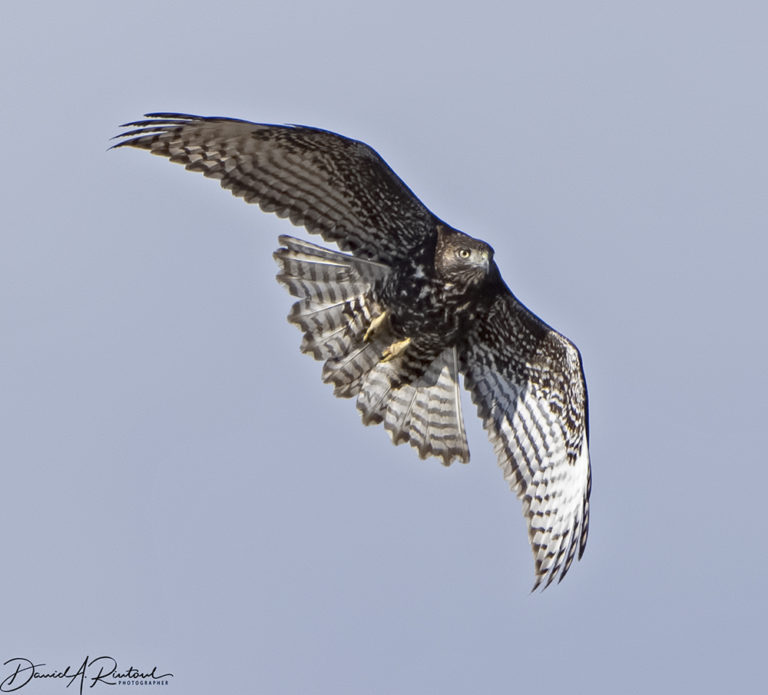
First-year Harlan’s Hawks will have that bright yellow iris, and a tail with wavy dark bands.
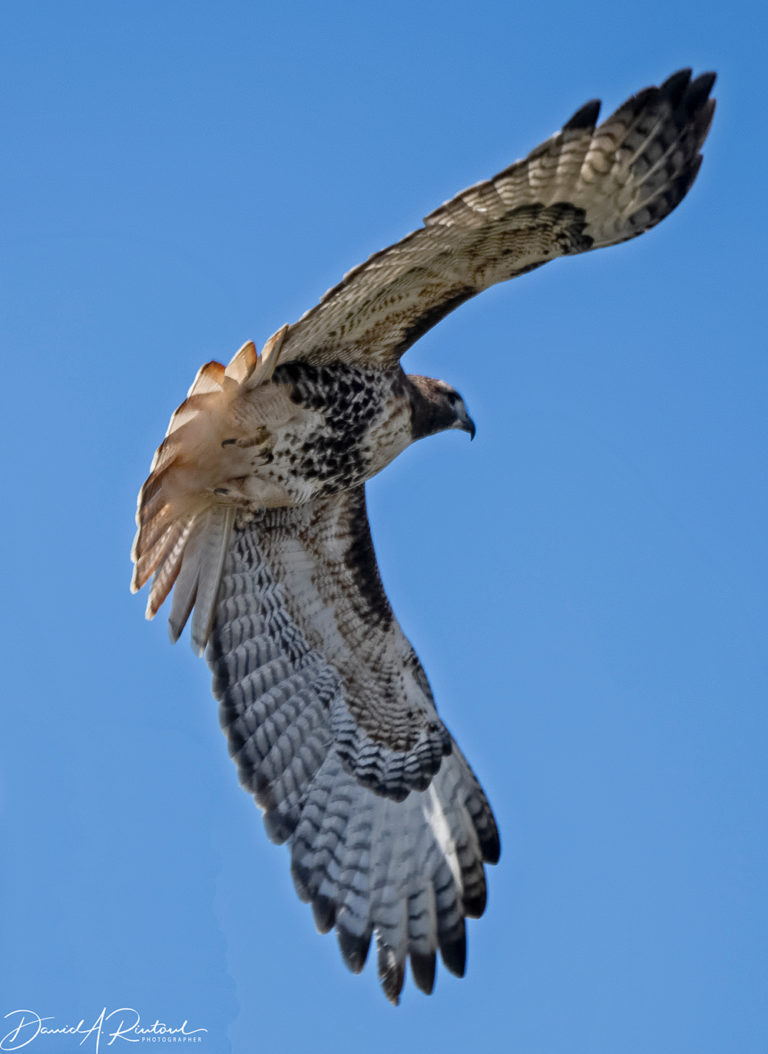
Another version of the Red-tailed Hawk often looks like this bird, representing the northern (abieticola) subspecies. These birds nest in the boreal forests of northern North America, and typically show that broad blobby bellyband as well as the colorful streaking from the head down toward the bellyband.
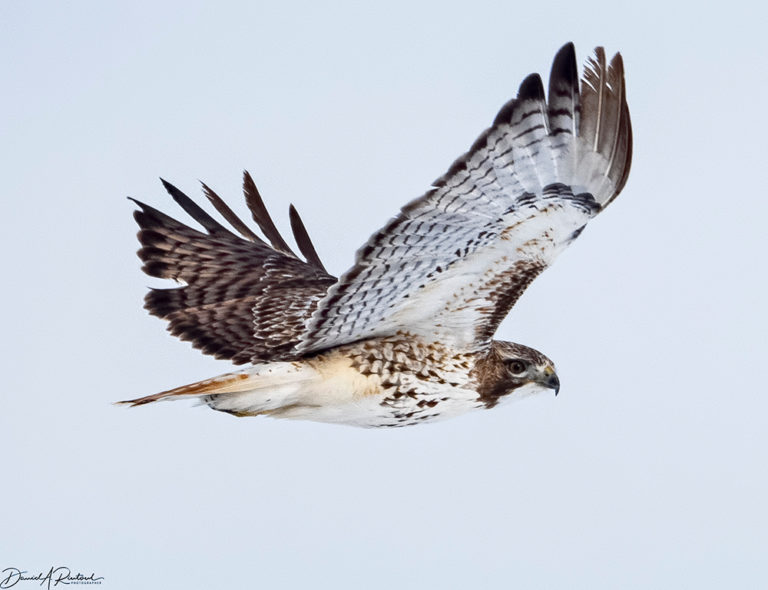
A typical eastern (borealis) bird, with a moderate bellyband and substantially less colorful marking on the underside of the wing, when compared to the bird in the previous image. That dark band at the leading edge of the wing, running from the body to the elbow (actually the wrist) is the patagial mark, and a dark patagium is also a good field mark for IDing a Red-tailed Hawk
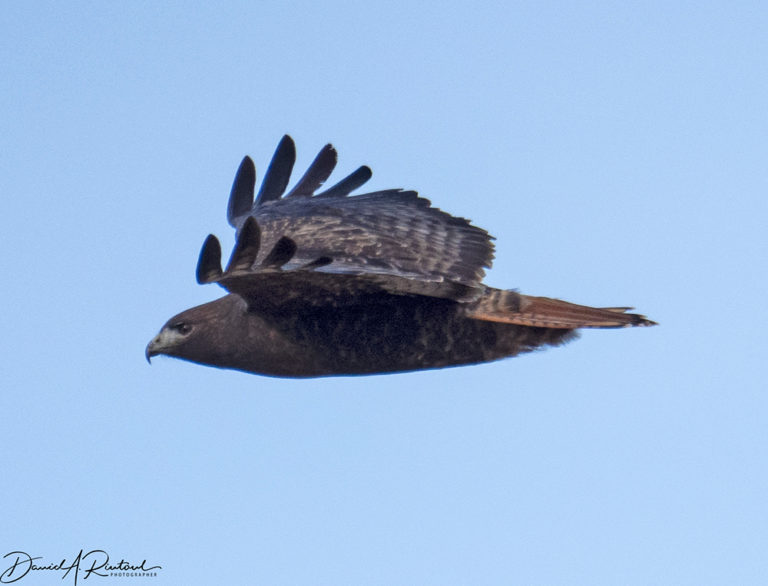
Another dark version of the Red-tailed Hawk is represented by this western (calurus) bird. They can be as dark as Harlan’s Hawk, but will show a more normal brick-red (usually banded) tail, and more rufous coloration. Nobody knows where our winter western redtails come from, but it is probably western Canada rather than the western US in most cases.
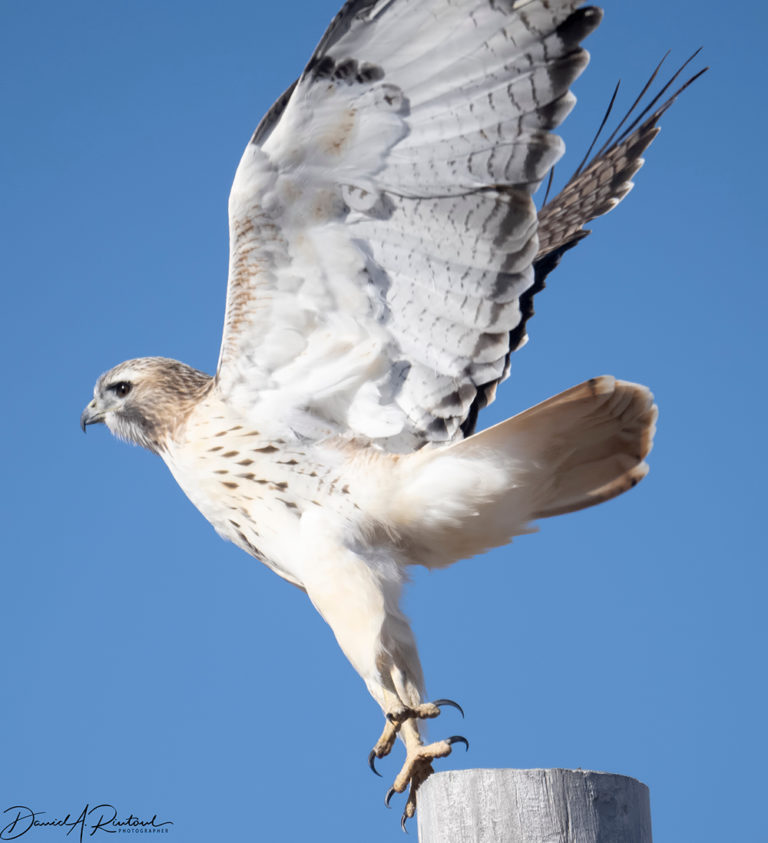
The rarest and palest Red-tailed Hawk of all, the Krider’s subspecies. Note the lack of markings on the underwing; even that patagial mark is muted and nearly washed out

mrmoshpotato
Whole lotta hawks. Great pictures Albatrossity. Thank you.
Betty Cracker
Such wonderful photos — thanks for sharing! Hawks are such fun to watch. I occasionally see red-tailed hawks, but red-shouldered seem to be more common in the swamp forest.
JPL
Hawks are amazing.
eclare
Amazing photos.
swiftfox
Surprised me during my time in Utah that red-tails were still the most common hawk in the Great Basin.
Mary G
Majestic birds, thanks Albatrossity!
MazeDancer
What remarkable pictures! Many thanks for sharing.
Ohio Mom
Last summer, a hawk swooped in to my suburban cul-de-sac and flew off with what must have been a chipmunk. Or maybe a squirrel.
It happened so fast, I barely registered what I was seeing. The friend I was chatting with was grossed out but I was delighted.
I see hawks all the time — don’t know what kind they are — either sitting erect on trees or the tops of utility ones, or circling slowly, but that was the only time I saw one catch it’s next meal. So elegant!
BretH
Thanks for the amazing photos and the information.
Quinerly
Gorgeous!
❤️???
Another Scott
@Ohio Mom: A couple of weeks ago I saw a juvenile red-shouldered hawk (according to the info at Cornell’s fabulous site) just off a hiking trail, watching and patiently waiting in a small tree for its breakfast to come out of a hole in the ground. We’ve had an explosion of chipmunks around here in the last few years, along with a lot more foxes. It’s nice to see nature coming back, at least a little, here in NoVA suburbialand.
Thanks Albatrossity!
Cheers,
Scott.
Dorothy A. Winsor
Amazing pics! I followed you on twitter to see more.
debbie
I once raised the window blind and came face to face with some sort of hawk eating a bird less than a yard away. It glared at me for a while and then returned to finishing off its snack. One last glare and then it was gone. Yikes!
Albatrossity
Thanks, all. There are indeed a lotta hawks around here in winter, and these pics are probably 0.1% of the images of hawks that I have found this year alone!
We get the Red-shouldered Hawks around here too, Betty, but that has been a recent (last 5-8 years) development. And we don’t have a lot of swamps, but they are usually found along streams and near ponds.
Re the calendars, since it is after the New Year, they are deeply discounted right now. In a few weeks they will be retired and unavailable, so if you still need a calendar, give them a look and see if one of those might be something you or a loved one can use.
karensky
Love me some redtails. Thanks. Just followed you on Twitter.
Wag
Fantastic photos! Out of curiosity, what’s your camera/lens setup? You use your tools very well.
ArchTeryx
Krider’s subspecies doesn’t look like a subspecies at all – it looks like a leucistic Red-Tail.
Leucistics are best described as partial albinos. They retain some pigment (thus are far hardier than their albino cousins) but look very washed out and whitish, exactly like the Krider’s Red-Tail.
Other thing to mention is where Red-Tails fit into the accipitrids (diurinal hawks). They’re a family of birds called buteos – think of them as mini-eagles. They mostly soar and glide, and stoop directly on prey on the ground.
Other commonly seen families are accipiters (Sharp-Shinned and Cooper’s Hawks) and falcons (Kestrels, Merlins, Prairie Falcons, the giant Gyrfalcons and of course the famous Peregrines). Accips have short, blunt wings and a lanky profile; they are specialized bird-killers. They can’t soar well and aren’t fast, but they can turn on a pinhead and chase small birds right into the bushes they use for cover. Falcons can eat a variety of prey, though the bigger ones are also specialized bird-killers; unlike accipiters they usually nab their prey by stooping on them in midair. They can’t soar at all, and must flap continuously to stay aloft – but they are the fastest animals on Earth.
rikyrah
These are stunning ????
Albatrossity
@ArchTeryx: Subspecies are defined not just by plumage, but by geographic range for the breeding population. In former years the Krider’s subspecies had a defined geographic range in the northern Great Plains. That range was then, and even more so today, encroached upon by other subspecies, so a pure Krider’s is a hard bird to find today. Nevertheless it’s not the same thing as a leucistic Red-tailed Hawk.
The lens and camera are lightweight, which I find to be important in making images of birds in flight. It is an Olympus mirrorless body (either the OM-D E-M1X or the E-M1) coupled to a Leica 100-400mm zoom lens. That mirrorless camera body has a smaller sensor, so the 100-400 mm translates to a 200-800 mm lens on that body.
sab
@Albatrossity: Is that Krider hawk taking off or landing?
Snarki, child of Loki
Great photos!
“you might like Ironic Birds of the World”
Yes, I would! Where can I find a copy?
Albatrossity
@sab: It is taking off, not landing. Sadly most hawks around here jump when you slow down to look at them; people are not generally their friends.
Snarki, that calendar is at http://www.lulu.com/shop/david-rintoul/iconic-birds-2020/calendar/product-24327516.html
Just One More Canuck
@Quinerly:
I had missed the post when you mentioned the news of Poco. I am so sorry.
Mike in Oly
Beautiful birds! Thanks so much for sharing them.
satby
Great as always Albatrossity! Thanks, now eyeballing the Hawks calendar.
scribbler
We often have a hawk (Cooper’s I think) looking for a meal in our yard. Since we have a lot of feeders, the hunt is often successful. It’s fascinating, and I remind myself that it’s a good thing to provide food for ALL the bird visitors to my yard…
OzarkHillbilly
I currently have a red tailed hawk the spitting image of the 2nd pic in residence on the property. So far s/he has shown no interest in my chickens.
I want to say thanks especially for the clues on identifying marks of the many different subspecies, especially the patagial mark. I did not know that was unique to red tails. We get subspecies here and I play hell identifying them. Now I know to look for that first and then I can concentrate on the other markings before I refer to my book.
Albatrossity
@OzarkHillbilly: There is also a great (and free) phone app for Android and iPhone that really helps with these IDs. It’s called Raptor ID, from Hawkwatch International, and you can find it in the Google Playstore or the Apple store online.
MelissaM
I can only think you are a magician to get such photos! I love how the wing undersides also look so fluffy on some of them (the last in particular.)
Husband saw a red-tail while walking on campus a few weeks ago. The bird was eating his lunch on the ground, a squirrel, outside of a vegetarian restaurant. In the picture he quickly snapped, squirrel spine was clearly visible!
?BillinGlendaleCA
@Albatrossity: Great shots, I’ve come to the conclusion that I just don’t have the lens to do a good job with birds. The longest zoom that I’ve got is 200mm on a APS-C sensor, so about 300mm full frame equivalent. I’ve got a colleague who’s constantly trying to get me out to shoot birds, I’m just not getting any results I like with my lens. ☹
otmar
Cool pictures.
I didn’t manage to submit something this week. Again.
Sorry, but I’m dealing with an emergency here.
TomatoQueen
Oh oh oh such beauties (never mind their eating habits ugh) just amazing.
Albatrossity
@?BillinGlendaleCA: Thanks. Yeah, at minimum you need 400 mm, and longer is better. For in-flight shots, even 800 mm is often not quite enough reach!
For what it’s worth, I don’t have the patience (or the night-owl temperament) to do night-sky images like yours. Those are lovely, and I’m glad you are making images like those!
Sister Machine Gun of Quiet Harmony
Gorgeous!
JDM
Trivia point: most people have heard a red-tailed hawk, even if they’ve never seen one. Their cry is often used in movies and TV, commonly as the sound of an eagle (because eagles have really high, squeaky voices).
JustRuss
Beautiful berbs! Beautiful pics.
Thank you.
I’ve had close encounters with (probably) red-tails a few times while biking and motorcycling. Always a thrill.
Charles Stannard
great images. Tack sharp. What lens are you using?
Albatrossity
@Charles Stannard: It is an Olympus mirrorless body (either the OM-D E-M1X or the E-M1 Mark II) coupled to a Leica 100-400mm zoom lens. That mirrorless camera body has a smaller sensor, so the 100-400 mm translates to a 200-800 mm lens on that body.
J R in WV
@Albatrossity:
When you speak of the Leica 100-400mm lens, are you referring to the Leica DG Vario-Elmar 100-400mm f/4-6.3 ASPH. POWER O.I.S. Lens from Panasonic… which appears to fit these Oly bodies?
I admire the partnership between Leica and Panasonic, they produce some fine equipment between them.
I have a fixed lens Panasonic Lumix with a 24-400mm superzoom, which is pretty handy. If I were to switch to a multi-lens set up I would have to carry a lot more bits of hardware. So tempted by these images, tho!!
Albatrossity
@J R in WV: Yep, that’s the one. It has image stabilization built into the lens, which seems to work pretty well.
Tehanu
Great pictures, thanks. BTW, you have the same name as one of my favorite actors, who’s Scottish – he was in one of the BBC Peter Wimsey (played by Ian Carmichael) mini-series of the 1980s, The Five Red Herrings. Any relation?
Albatrossity
@Tehanu: No relation. And that is not his real name, I understand. He was given the name David Wilson at birth, and changed to Rintoul (a common surname in Scotland) when he got into acting.
Tehanu
@Albatrossity: Thanks for replying. I guess this isn’t the first time anybody asked you this!